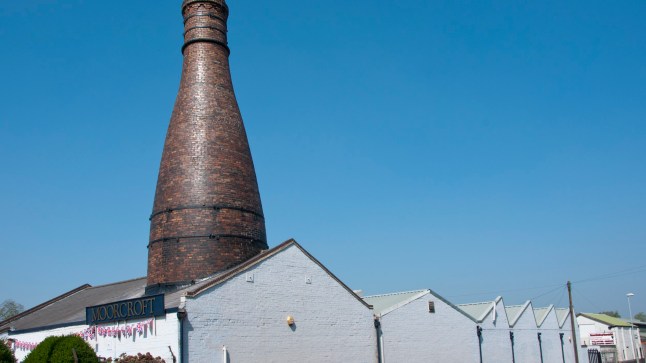19 Mar, 2025 | Admin | No Comments
Martin Lewis issues 10-day warning to qualify for £100 Nationwide bonus payout


Last year, Nationwide paid 3.85 million members £100 each as part of its Fairer Share scheme — and it looks like the building society will be issuing a fresh round of bonuses in the next few months.
While the exact details of the 2025 initiative – which is separate to recent £50 payouts marking Nationwide’s acquisition of Virgin Money – have yet to be released, Martin Lewis has offered some urgent advice to help you qualify.
In the latest edition of his Money Saving Expert (MSE) newsletter, he shared a guide on possible conditions for the ‘reward’, urging: ‘Go quick to boost your chances.’
MSE explained: ‘In previous years, the scheme has been announced in May and paid in June, though whether you got it depended on if you met the qualifying criteria in the first three months of the year.’
That means existing members have just a few weeks left to ensure they fulfil any requirements, while non-nembers need to switch to Nationwide ASAP to be eligible.
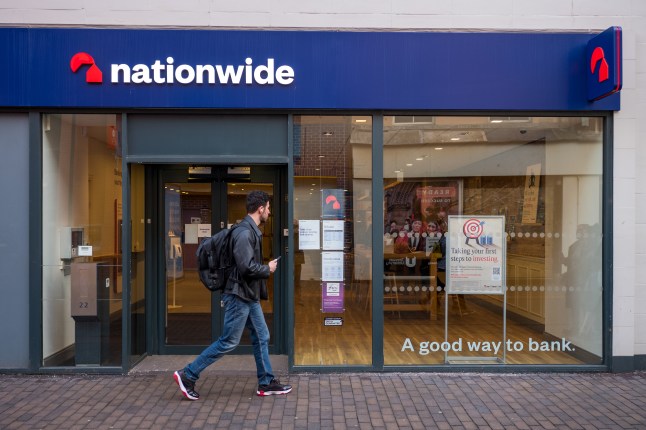
Assuming the initiative comes with the same prerequisites as in 2023 and 2024, what you have to do will depend on the account you have and how you used it in January or February this year.
If you’re already a Nationwide customer, your account must still be open on March 31, 2025, so don’t close it between now and then. Additionally, you need to have used it within the first three months of the year, with slightly different criteria for different types of account:
FlexAccount, FlexBasic, FlexDirect accounts
To qualify for a Fairer Share payout, you must have either received £500 and made two payments out of your account, or made at least 10 outgoing payments in January and February this year.
However, MSE adds that if you didn’t do this, ‘you may still be able to qualify by switching.’
FlexPlus packaged accounts
No payments in or out are required here, but you need to have kept up with your fee to be eligible.
FlexOne, FlexGraduate, FlexStudent accounts
The deadline for these members is slightly later, so you’ll have until the end of March to qualify by making at least one payment in or out of your account.
‘Payments out can include debit card transactions, Direct Debits, bank transfers and standing orders but not transfers to other Nationwide accounts you have,’ explains the MSE site.
Mortgages and savings accounts
Mortgage customers must owe at least £100 by end of March, while savings accounts must have a balance of at least £100.
MSE advises: ‘If you don’t have either of those, stick £100 (or maybe £200 to be safe in case it changes its terms) into one of Nationwide’s savings accounts before Monday 31 March.’
Not with Nationwide or missed the deadline to qualify?
If you use the Current Account Switch Service to switch an account you hold with another bank to a Nationwide FlexDirect one by March 31, you may still meet the criteria for the £100 Fairer Share payment — and you may even be eligible for a £175 new customer bonus too.
Keep in mind though, there isn’t long left to act, as the process normally takes seven working days to go through.
Alongside switching your current account, MSE recommends you also ‘stick £100 (or £200 to be even safer) into a Nationwide savings account or owe at least £100 on a Nationwide mortgage in March 2025′ to maximise your chances of qualifying.
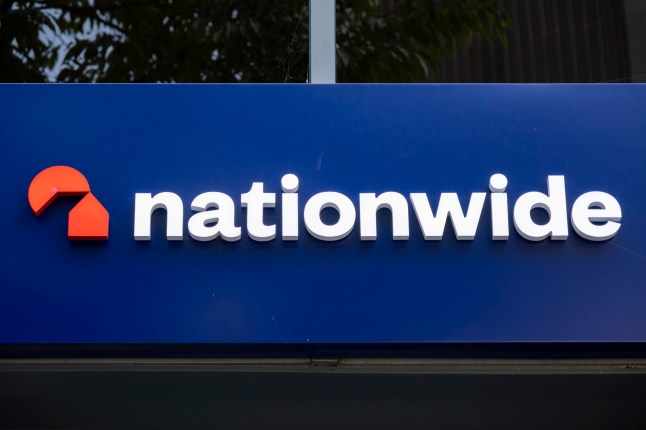
When will the Nationwide bonus be paid out?
Last time around, the bank contacted eligible members by May 31, with bonuses deposited into members’ accounts between June 13 and June 28.
Nationwide plans to release information such as the amount and exact payout dates around the same time in 2025, so there’s still a while to wait.
However, all the hard work’s done for you, so you don’t need to make a claim or request the money yourself.
If you think you qualify and haven’t heard anything from Nationwide by June, get in touch. And don’t forget to stay aware of fraudulent attempts at obtaining your personal information to apply for the payment.
Do you have a story to share?
Get in touch by emailing MetroLifestyleTeam@Metro.co.uk.
18 Mar, 2025 | Admin | No Comments
Aldi branded ‘top tier’ for offering free period products in UK supermarket first


You may notice something different about Aldi on your next visit, with a new change being praised for ‘setting an example’ by shoppers.
Today, the retailer became the first major UK supermarket to roll out free period products across its in-store toilets – no code word or loyalty scheme needed.
By the end of May 2025, all locations will be be fitted with fixtures stocked with tampons and pads, allowing customers to simply take what they need when they need.
Aldi has also partnered with Bloody Good Period, pledging to donate over a million period products to support the charity’s fight against period poverty.
The move comes after new research from the supermarket which found 41% of people who menstruate admit they’re unable to afford to buy period products – 15% of whom say this is ‘very often’ or ‘always’ the case.
Additionally, third of Brits (30%) have had to decide whether to buy period products or choose other essential items for themselves and their family, with milk, fresh fruit and veg, bread, and household cleaning supplies among the items most likely to be sacrificed.
Clara Amfo, broadcaster and Bloody Good Period ambassador, commented: ”Aldi partnering with Bloody Good Period to raise awareness of period poverty and providing free products in their store toilets is a fantastic step in the right direction that will help millions across the country.’
‘We never want our customers to have to choose between buying the period products they need and feeding themselves or their families,’ added Julie Ashfield, chief commercial officer at Aldi UK.
‘For millions of people across the country, having access to period products is a basic and essential need, and we believe the provision of these in public toilets is as vital as toilet paper and soap.’
Customers welcomed the news, including @Rob140638 who wrote on X: ‘Well done to @AldiUK… Setting an example.’
‘Aldi winning again,’ said Sarah Maslen-Roberts on Facebook, while Natalie Rachel Chand wrote: ‘Yes Aldi UK, this is not a choice or a luxury, it’s a necessity! Thank you for being part of the solution.’

Another commenter, Emily Louise Denton, added: ‘This is top tier! I cannot believe in this day and age that girls and women should go without, struggle to afford or make do with something so natural that we don’t have a choice over. Well done.’
This follows a Morrisons scheme whereby shoppers can ask staff for a ‘package for Sandy’ to be discreetly given a pack with two pads inside.
Last year, the Scottish government also made history with a law making it compulsory for public places such as schools, colleges and universities, libraries and leisure centres to provide menstrual products free of charge.
Although it’s not legally required elsewhere in the UK, you can check for local hubs offering free period products near you via the My Period Live website – or, if you’re in a position to, find out where you can donate much-needed sanitary items to help people in your neighbourhood.
Do you have a story to share?
Get in touch by emailing MetroLifestyleTeam@Metro.co.uk.
18 Mar, 2025 | Admin | No Comments
The hours you need to work to afford an ‘average’ life in different UK cities revealed


If you feel like you’re working all hours without much to show for it, the maths is in proving you’re probably right.
A new study has analysed the number of hours you need to work to afford a comfortable lifestyle in 45 cities around the UK — and it’s pretty depressing reading.
Expenses like rent, bills, food, transport and leisure activities were compared average salaries in each city, creating a ranking of the best (and worst) when it comes to work/life balance.
‘Our study shows how hard it’s becoming for people to balance work and the cost of living in the UK’s biggest cities,’ commented David Overmars from CVwizard, who compiled the research using ONS data.
‘With rents and everyday expenses going up, many are having to work longer hours just to get by. This highlights the need for better solutions — higher wages, more stable living costs, and a work-life balance that lets people enjoy life without working nonstop just to afford it.’
Perhaps unsurprisingly, London came out as the place where you need to do the most work to stretch to an ‘average’ standard of living; 2394.51 hours a year, to be exact, which equates to over 46 hours a week.
Despite having the highest median net salary of £34,189.20, rent is significantly higher in the capital than the other cities studied, with a whopping 76.8% of all working hours going towards this alone.
In at second was Oxford, whose residents need to put in
2139.71 hours a year – just over 41 a week – to cover the cost of a decent standard of living.
Top 10 cities where living requires the most work hours
- London: 2394.51 annual hours/46.05 hours per week
- Oxford: 2139.71 annual hours/41.15 hours per week
- Manchester: 2139.20 annual hours/41.14 hours per week
- Bristol: 2135.02 annual hours/41.06 hours per week
- Nottingham: 2033.14 annual hours/39.10 hours per week
- Birmingham: 2017.97 annual hours/38.81 hours per week
- Norwich: 1981.45 annual hours/38.10 hours per week
- Southampton: 1978.35 annual hours/38.05 hours per week
- Glasgow: 1945.63 annual hours/37.42 hours per week
- Newport: 1920.54 annual hours/36.93 hours per week
Research via CVwizard.
While rent in the historic cathedral city is lower than the Big Smoke, utilities are more expensive, totalling to 243.5 working hours each year for the likes of electricity, mobile phone plans, and fast internet.
Third on the list was Manchester, followed by Bristol and Nottingham. A comfortable life in each of these locations means dedicating at least 2033 hours a year to work, which sits on the higher end of the ‘full time’ spectrum at 39 hours every week.
In contrast, Southend-on-Sea offers a median net salary £32,642.40, withrelatively low rents at roughly £840.33 per month and low utility and leisure costs, making it the best for work/life balance.
Here, residents need to work just 1364.24 hours a year, or less than 27 a week, to afford an average life — plus it’s by the beach, which is always an extra bonus.
Top 10 cities with the best work/life balance
- Southend-on-Sea: 1364.24 annual hours/26.24 hours per week
- Aberdeen: 1479.98 annual hours/28.46 hours per week
- Mansfield: 1509.80 annual hours/29.03 hours per week
- Northampton: 1562.30 annual hours/30.04 hours per week
- Bradford: 1575.65 annual hours/30.30 hours per week
- Dudley: 1591.29 annual hours/30.60 hours per week
- Sunderland: 1597.22 annual hours/30.72 hours per week
- Kingston upon Hull: 1614.13 annual hours/31.04 hours per week
- Stoke-on-Trent: 1636.15 annual hours/31.46 hours per week
- Derby: 1637.75 annual hours/31.50 hours per week
Aberdeen was next up, while Mansfield, Northampton and Bradford rounded out the top five. If you’re looking to get out of the rat race, these are the places to be, requiring 30 hours a week or less to cover everyday expenses and a few treats here and there.
A growing backlash against ‘hustle culture’ has arisen in recent years, with comments from Google CEO Sergey Brin calling 60 hours a week the ‘sweet spot for productivity’ drawing harsh criticism online.
‘I’m not working 12 hours a day because some tw*t thinks money matters more than having a life,’ tweeted @Farore13, while @milolzx wrote: ‘We are humans and we deserve rest and a life outside of work.’
In response to increasing levels of overwork, nearly 1 in 5 employees (19%) are instilling greater boundaries by not taking on tasks outside of their specific job descriptions, and a further 20% say they refuse to answer work messages outside of their contracted hours.
Do you have a story to share?
Get in touch by emailing MetroLifestyleTeam@Metro.co.uk.
16 Mar, 2025 | Admin | No Comments
Inside the baby bank: ‘People never think they will be in this position’


Carly keeps a watchful eye out the window of Babyshed’s headquarters in Stevenage, Hertfordshire.
With items like nappies, formula milk and baby wipes available, the charity has become a lifeline to mums in the area. Reaching out for help for the first time can feel daunting, however.
‘We want people to come in and not feel judged,’ Carly, Babyshed’s coordinator, tells Metro. ‘There was one lady who sat in the car for half an hour crying her eyes out because she was so embarrassed to come in. People shouldn’t feel scared to ask for help.
‘Sometimes you see people literally shaking as they come in, they never thought they would be in this position. It can be very unexpected, like when a woman has a baby then her husband leaves. Nursery costs are so high which means they might not be able to go back to work, or they might not feel ready to.’
When Metro visits Babyshed on a crisp, cold day, there’s a steady stream of new mums passing through. They gather around a play mat as their babies gurgle and giggle. The temperatures are due to drop this weekend, so there’s a selection of winter jackets on display alongside more usual items like baby food and nappies.

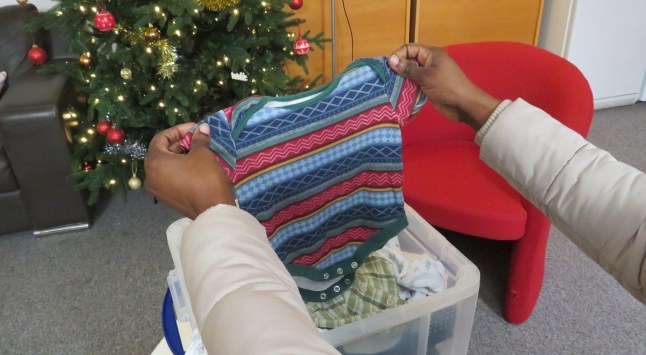
‘I came into the country from Nigeria as a student with my husband,’ one mum, who prefers to stay anonymous, tells Metro. The 31-year-old has a six-month-old boy and lives in the town centre of Stevenage. ‘When I gave birth I was still studying so my finances weren’t okay. We had to pay bills, school fees, payments – it was a lot. As the baby grew, it became hard to afford new clothes.
‘I went to Bedfordshire Foodbank to get some things and the staff there told me about Babyshed, it was much closer to me. My first time here, I remember I stood outside and felt really scared about how they might treat me. But then I came in and knew I didn’t need to be scared. I was treated with love. They are so supportive. I’ve got things like nappies, wipes and toiletries here. Sometimes I forget to ask for things and they go “oh, do you need this as well?”’
‘This is my fourth time here,’ another mum, 31, explains as her eight-month-old plays nearby. ‘It has been a lifesaver. Whenever I need anything I think “Babyshed.” Without it, I would find a way to survive, but it would be very difficult.’
Babyshed was launched following the Covid-19 pandemic by Stevenage Vineyard Church to support families in need. The charity has gone on to become vital for nearby refugees housed in a local hotel, with volunteers making a dedicated trip each week to offer support.

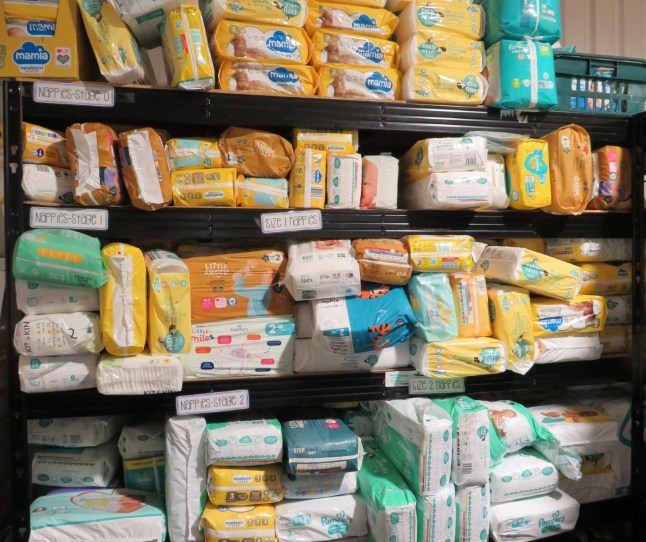
Carly heads through a set of doors to a vast warehouse where donations are stored. Shelves of nappies stretch down the room, new prams are illuminated by the winter sun and boxes of baby food are neatly labelled. There’s also drawers for more specific items, like breast pads, nappy cream and cotton wool. Carly wants to give mums as much autonomy as possible.
She continues: ‘Just because someone is in a certain section of their life, it shouldn’t mean they lose the ability to choose. I think things like, does this mum like Disney? Would she prefer frilly outfits? Will this family be outdoors a lot? The same baby clothes don’t suit everyone. We also don’t mind second hand donations, but we want good quality. I wouldn’t want to give something out which I wouldn’t feel comfortable using for my own kids.’
SIGN METRO’S FORMULA FOR CHANGE PETITION HERE
In one heartbreaking incident last year, a police officer informed Babybank staff he had been forced to arrest a woman who stole formula milk. He took a leaflet from the charity to give to her. Babyshed – which is backing Metro’s Formula for Change campaign that aims to improve access to essential items like formula – want mums to feel empowered to reach out for help.
‘Everybody is one short step away from poverty,’ Carly adds. ‘If your life circumstances have led that way, it doesn’t make you any less of a human being or a good mum.
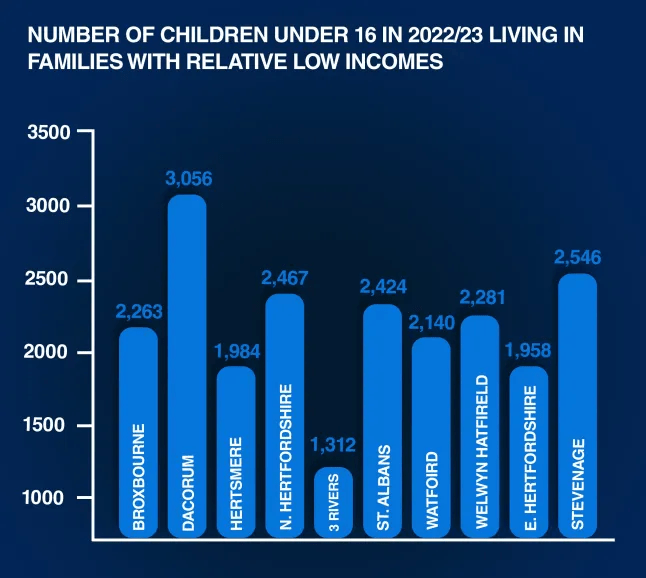
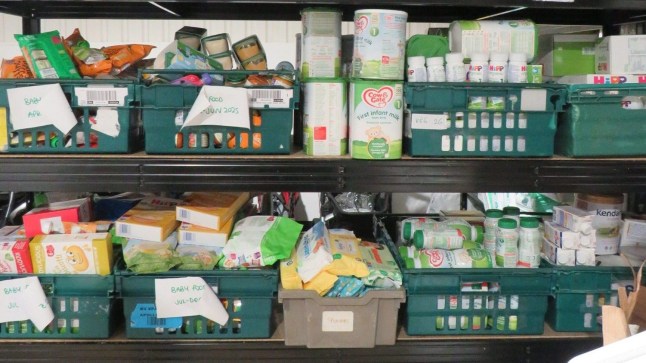
‘We want to help facilitate people to be the best parents they can be, we’re non-referral so anybody can come here. Come, see us, have a hot drink, have a chat, have a cry.
‘It might look like we’re just giving someone a pack of nappies, but it’s much more than that. It’s a vehicle for change. Some of the mums we support actually come back and give us donations once they’re back on their feet. It’s always really special to see that. If you throw a stone, it causes ripples. We want ripples of kindness to spread as far as they can.’
There are ten volunteers at Babyshed and extra support from the local community vital. Bags of sweets have been delivered from Tesco this morning while staff from GSK, a pharmaceutical company in Stevenage, recently visited the charity to paint the walls.
Babyshed has also received several vouchers from a local trampoline park, which means parents they support will be able to treat their child to a special day out they might not otherwise have been able to afford.

When Ann arrived for her first volunteering shift at her local baby bank, she could never foresee just how much of an impact she would have. The mum-of-three had previously helped with a foodbank run by Stevenage Vineyard Church, where she had been pastor.
‘Some people just want someone to talk to,’ Ann tells Metro. ‘They might not have their own support system or a mum of their own to help. I remember one woman walked in through that door and just burst into tears, it turned out she was pregnant and her husband had just left her.
‘One day she said, “I thought I could do this by myself, but I can’t. I know this is a really big ask, but would you be with me at the birth?” Of course I said yes. I cut the baby’s cord and cuddled him, it was absolutely wonderful.
‘His mum still tells me “when he hears your voice he looks for you in the room.” She doesn’t come back here a huge amount, because she’s back on her feet now with a new job and a council house.’
Support the work of Babyshed by clicking here

Call me boring if you want, but I love a good supermarket shop.
Take me to big Tesco or Sainsbury’s and I’ll be in my element looking at homeware and cute pyjamas that I don’t really need, before stocking up on my favourite snacks. Simple pleasures and all that.
It shouldn’t come as much of a surprise then, that going to Costco for the first time ever would be a big deal for me.
Standing outside the warehouse in Hayes, I was giddy with excitement. It wasn’t quite on par with the way a child feels at Disneyland for the first time, but it was up there.
The wholesale chain has pretty strict membership criteria and I’d never previously met the requirements to get in. But thanks to my husband switching jobs, that had all changed.
Finally armed with my very own Costco card I headed inside the store… and was met with utter chaos.

If you’ve never been to Costco before, it’s my duty to warn you never to go on a weekend – it’s akin to being in London when the Christmas lights are switched on, or at a UK beach in the height of summer. There were people absolutely everywhere and endless queues, both to get into the store and for the checkouts. It isn’t for the weak.
The layout of the shop itself was also rather chaotic, although this is definitely part of the experience. I never knew what I was going to find from one moment to the next – there were sports bras on a shelf next to blenders, and children’s toys near power tools.
While I was busy adapting all of this, my husband, who usually hates any form of grocery shopping, was having a blast. According to him it’s because the warehouse set up feels remarkably like being in a B&Q, thanks to the really tall shelving, as well as the drills and furniture for sale.

We quickly realised we’d never be able to do a proper grocery shop here. Everything is sold in bulk, which is ideal if you’re running a business or feeding a large family, but rather unnecessary for just the two of us, as there’d be too much waste.
That said, there were some store cupboard essentials, that would not only last for ages, but proved to be better value when bought this way.
For instance, a 600g tub of Marmite cost us £5.99 at Costco, while a 250g jar is £3 at Sainsbury’s (our nearest shop). Similarly, Twinings English Breakfast Tea Bags are £4.80 for 80 bags at Sainsbury’s, but £7.99 for 300 bags in Costco.

And it’s not just kitchen staples, there were more bargains to be found in the toiletries section, with a 96 pack of Tampax Pearl Compak costing £11.99. In comparison, a 16 pack is £3.25 at Sainsbury’s. You do the math.
For the Micellar Water girlies, this is also notably cheaper to buy at Costco, with a two-pack of 700ml Garnier bottles costing £8.49 – at Boots, one 700ml bottle is £9.99.
Not everything was necessarily good value for money though, especially products in the bakery section. A 12 pack of croissants was priced at £5.49, whereas 12 croissants in Sainsbury’s work out at £3.20.
I also audibly gasped when I saw that a six-pack of chocolate muffins was going for £7.99, but thankfully a kind stranger pointed out the fine print on the label, which said you could get two packs for £7.99. There were a few sneaky offers like this, so definitely worth keeping your eyes peeled to get the most bang for your buck.
Outside of nabbing a bargain, you can get pretty much everything and anything from Costco, including an eye test for £19.99 at the in-store opticians. Over the course of our two hour exploration of the store we also found a £73,000 diamond ring (who is buying this from Costco?!), smutty fantasy books, and salvage palettes which contained everything from clothing, to nappies and washing machines.

There were two things that really surprised me during our visit though – one positive, the other not so much. We’ll start with the negative.
I was gobsmacked by how much money we spent, despite shopping pretty carefully. Our haul was mostly practical purchases like cereal, spaghetti, cheese, vegetables, condiments, and butter.
We’d tried to limit the number of ‘rogue’ items we added in for the hell of it, although we did also take home a tub of pretzels bigger than my head, a pack of 36 Babybels and a tray of 24 of the viral cookies (sadly not worth the hype, too artificial tasting).
Our total spend came to over £100, which is more than our weekly shop, and we had much less food to show for it. I was flabbergasted, and had immediate buyer’s remorse. I pushed the trolley from the till to the food court by the exit in a bit of a daze.

After all that shopping, we’d definitely worked up an appetite so we ordered a slice of pepperoni pizza, a hot dog and soda.
Little did we know that this pit stop at the back of the store would be the highlight of the whole visit.
I was sceptical about the kind of food we’d receive from what was essentially a hatch at the back of a warehouse, especially given that it was so cheap – £1.50 for a hot dog and drink and £1.99 for a slice of pizza – but the food really blew me away.
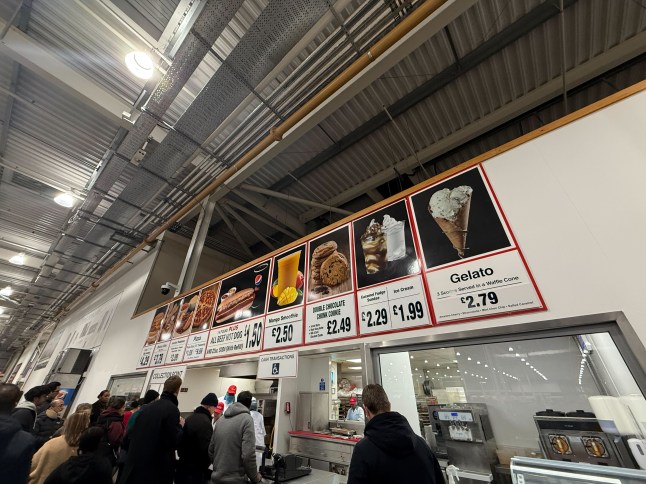
The pepperoni pizza was better than the likes of Domino’s, Pizza Hut or Papa John’s. That’s fighting talk, I know, but I’m not the only one who thinks it. Reddit users agree, even going as far as to proclaim it the ‘best takeaway pizza in the whole of the UK’.
I enjoyed it so much, I was already chomping away before I remembered to snap a quick pic for this article, hence the giant bite mark.
My husband felt similarly about the beef hot dog, which can be ordered with or without onions, and along with a soda of your choosing for less than £2. He could have added in an ice cream as well and the price would still have put supermarket meal deals to shame.
There’s plenty more on the menu, including a chicken sandwich, jacket potato, chicken and bacon bake, gelato, plus those famous cookies, which can be bought individually – something I wish I’d known before buying 24 of them.
Everything was under £5, except for whole pizzas which cost £9.99, but in today’s climate, that’s still felt like a steal.

The only downside was that there were only a handful of seats in the food court, and like the rest of the store it was heaving with people. Being too hungry to wait for a table, we tucked in there and then slumped over the handlebar of our trolley.
The pizza was messy and theawkward standing position made for one of the most undignified eating experiences of my life, but I enjoyed the meal none the less.
Will I be going back to Costco again any time soon?
I’d go back for another slice of the pizza in a heartbeat, but I’m no longer feeling the same levels of excitement about shopping there. But that’s ok, because it’s not really meant for me.
If I’m ever planning a big dinner party it could be worth another visit, but otherwise I think I’ll be sticking with Sainsbury’s and Tesco for now.
Do you have a story to share?
Get in touch by emailing MetroLifestyleTeam@Metro.co.uk.
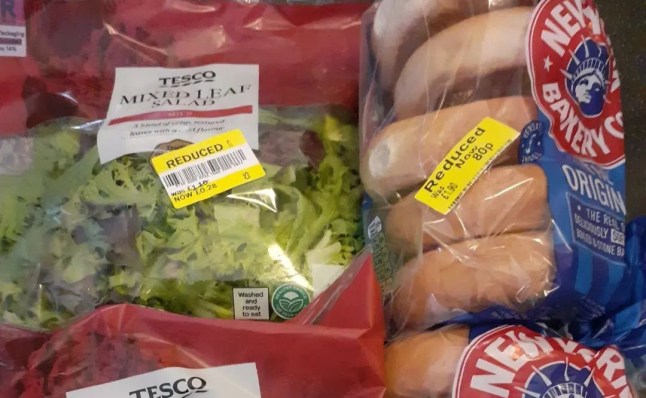
A major British supermarket will hand out food for free in a bid to reduce food waste and hit net zero goals.
Tesco plans to give away food which is about to go out of date at absolutely no cost.
The cost-slashing yellow sticker will be revolutionised and mean marked items are completely free after 9.30pm.
Potentially thousands of tonnes of food could avoid the bin and go home with customers.
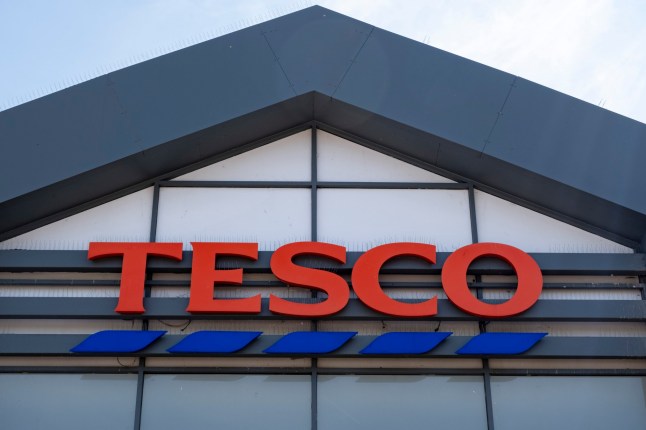
The plan will first be trailed in a small number of Express stores across the country.
At present, Tesco’s yellow label system reduces the cost of food items by 90%.
The supermarket also gives unsold food to charities in order to reduce the amount of produce they have to throw away, which they will continue to do under the new scheme.
Despite these schemes, Tesco reported more than 35,000 tonnes of food waste in the UK last year.
But now staff will get priority on food which have been reduced earlier in the day and then customers will be able to take home almost out-of-date items in the run-up to closing time.
An internal memo said the plan would allow Tesco to ‘continue with our drive to reduce food waste within our own operations’, The Telegraph reports.

Tesco has pledged to be ‘carbon neutral’ by 2035 and net zero by 2050
The supermarket chain has already cut food waste by 18% between 2017 and 2023, with its long term goal being a 45% reduction.
The store has already redistributed 166 million meals through their Community Food Connection Scheme, according to their 2024 food waste report.
A spokesman for the supermarket said: ‘We are constantly looking for innovative new ways to reduce food waste.
‘This trial, in a small number of our Express stores, will allow customers to take any remaining yellow stickered items for free at the end of the day, after they have first been offered to charities and colleagues.’
Get in touch with our news team by emailing us at webnews@metro.co.uk.
For more stories like this, check our news page.
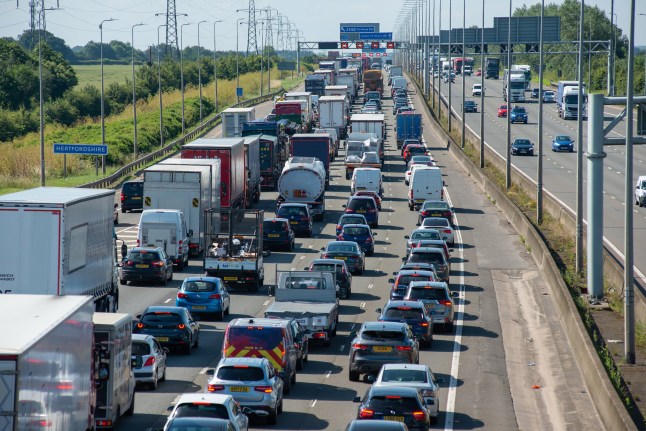
Owners of 54 models of old classic cars could face eye-watering tax hikes very soon from the DVLA.
Vehicle Excise Duty (VED), often known simply as road tax, sees people who drive or keep their cars on public roads pay an annual fee. But this year, the charge is set to increase for almost all petrol and diesel owners.
First-year VED rates will double, meaning that brand-new polluting models may pay more to be behind the wheel.
But cars registered between 1984 and 2001 will be hit hard by the tax overhaul as they fall under a different tax system. Experts say drivers in the lower power bracket will pay £220 in 2025/26, a hike of about £10 from £210 per year.
The tax increase affects Audis, Volkswagens, and even Lamborghinis. Those with more powerful engines above 1549cc will have to cough up £15 more every year, shooting up from £345 to £360.
But vehicles producing more than 255 g/km of carbon dioxide will see a £2,745 increase.
The rules will be rolled out by the Driver and Vehicle Licensing Agency (DVLA) from April.
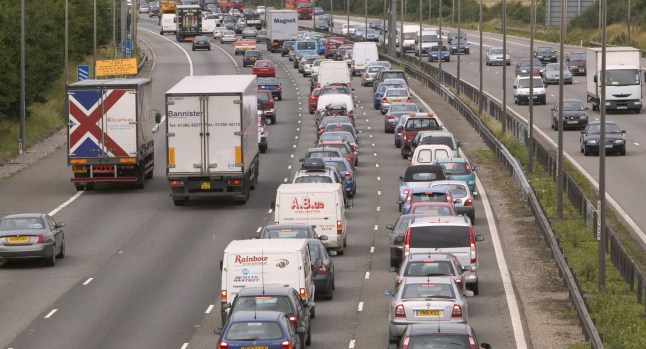
New roadworthy car owners are expected to pay an additional £418 on average, according to GoCompare.com.
Diesel cars will be stung the hardest, however. The average increase will be £1,113, about double the rise facing petrol drivers.
Zero-emission vehicle drivers – think electric cars (EVs) – will no longer benefit from being tax-free for the first year.
Full list of vehicles affected
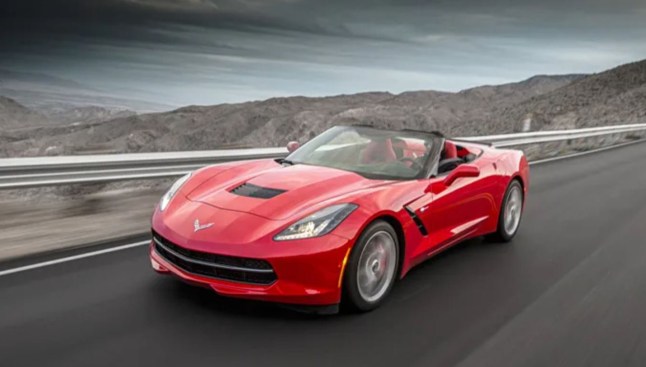
- Audi RS6 4.0 TFSI V8
- Audi S8 4.0 TFSI V8
- McLaren GT 4.0T V8
- Audi R8 5.2 FSI V10
- Lamborghini Huracan 5.2 V10
- Chevrolet Corvette Stingray 6.2 V8
- Volkswagen Amarok 3.0 TDI
- Aston Martin DBX 4.0 V8
- Ferrari Roma 3.8T V8
- Audi SQ7 4.0 TFSI V8
- Range Rover Sport 4.4P V8
- Jaguar F-Pace 5.0 P575 V8
- Aston Martin DB12 4.0 V8
- Porsche 911 3.7T 992 Turbo
- Jeep Wrangler 2.0 GME
- Ford Ranger 2.0 TD EcoBlue
- Audi RSQ8 4.0 TFSI V8
- Lotus Emira 3.5 V6
- Bentley Continental 4.0 V8
- Audi SQ8 4.0 TFSI V8
- Aston Martin Vantage 4.0 V8
- Toyota Hilux 2.8D
- Porsche Macan 2.9T V6
- Mercedes-Benz SL55
- Range Rover 4.4 P530 V8
- Mercedes-Benz AMG GT 4.0 V8
- Porsche 718 Cayman 4.0 GT4
- Lamborghini Urus 4.0 V8 BiTurbo
- Audi RS7 4.0 TFSI V8
- Ford Mustang 5.0 V8
- Toyota Land Cruiser 2.8D
- Bentley Continental 6.0 W12
- Mercedes-Benz GLC63
- Ford Ranger 3.0 V6
- INEOS Grenadier 3.0P
- Range Rover 4.4 P615 V8
- Land Rover Defender 90 5.0 P425 V8
- Rolls-Royce Ghost 6.75 V12
- Ford Ranger 3.0 EcoBlue
- Mercedes-Benz G63
- Ferrari Purosangue 6.5 V12
- Rolls-Royce Cullinan 6.75 V12
- Alfa Romeo Stelvio 2.9 V6 Bi-Turbo
- Mercedes-Benz GLE63
- Maserati Levante 3.0 V6
- Porsche Cayenne 4.0T V8
- BMW M8 4.4 V8
- Maserati MC20 3.0 V6
- Land Rover Defender 110 5.0 P425 V8
- Mercedes-Benz G400D
- Lamborghini Revuelto 6.5 V12
- Bentley Bentayga 4.0 V8
- BMW X7 M 4.4 V8
- BMW X6 M 4.4 V8
- BMW Alpina XB7 4.4 V8
- Bentley Flying Spur 4.0 V8
- Maserati Levante 3.8 V8
- BMW X5 M 4.4 V8
- Mercedes-Benz GLS63h
People who buy hybrid cars from April will pay an extra £135 and £327 extra on average. GoCompre says this is based on the model, however.
Tax rates are largely based on how much CO2 fossil-fuel-guzzling cars spew out – higher emission vehicles are placed in higher VED bands.
More Trending
Vehicles manufactured after 2001 don’t have the size taken into account.
VED increases will be in line with inflation, HMCR confirmed, much the same as it did last year.
HMRC said: ‘This measure will uprate the Vehicle Excise Duty rates for cars (excluding first year rates) and all other rates for vans, motorcycles and motorcycle trade licences by the Retail Price Index, and will reflect the inclusion of zero-emission vehicles in Vehicle Excise Duty from 1 April 2025.
‘This is a standard uprating that comes into effect from 1 April 2025.’
Get in touch with our news team by emailing us at webnews@metro.co.uk.
For more stories like this, check our news page.
26 Feb, 2025 | Admin | No Comments
Martin Lewis issues urgent four-day warning to save on UK rail travel


Looking to shave a few pennies off your UK rail travel? According to Martin Lewis, you’ve got just four days to unlock a nifty discount.
The beloved Railcard is a widely used way to unlock savings on UK-wide train travel – and some of them, including the 16-25 and 26-30 versions, can even be connected to an Oyster card to whack 1/3 off off-peak travel on selected TfL services.
Now, the money-saving expert has reminded rail enthusiasts that there’s a limited period to nab a cheeky 25%-off deal – and pay £22.50 for a one-year Railcard or £52.50 for three years.
At present, the price comes in at £30 per year (or £70 for three years). This is set to rise to £35 and £80 respectively on March 2, as explained in this week’s MoneySavingExpert.com newsletter.
If you’re new to either TrainPal or Trip.com (both of which are third-party booking sites), you can use an exclusive code to access 25% off a digital Railcard – before the new price hikes.
‘To get 25% off a digital Railcard via TrainPal, use the code MSE25 (if buying through its app you’ll also need to purchase a train ticket to activate the Railcard…if buying through its website you won’t need to do this),’ the MSE newsletter reads.

If you’re going via Trip.com, simply use the code MSETRIPRC25, though you’ll need to buy a train ticket to activate it, and this needs to be done before March 2.
The same applies if you’re making your purchase through the TrainPal app, but notably, not through the TrainPal website, which will automatically activate it for you.
‘Neither site charges a booking fee, and there’s no minimum spend, so if you need to buy a ticket to activate your railcard, you could just buy the cheapest possible fare,’ MSE adds.
‘While the ticket needs to be bought before 2 March, it can be valid for travel after this date. If you don’t activate your railcard (this only applies to those purchased through the TrainPal app or via Trip.com’s site or app), you’ll be issued an automatic refund.’

Critically, the code can only be used to buy a 16-17 Saver, 16-25 Railcard, 26-30 Railcard, Family & Friends’ Railcard, Network Railcard, Senior Railcard and Two Together Railcard. It doesn’t include the Disabled Person’s Railcard or the Veterans’ Railcard.
You also won’t be able to transfer your purchase to the official Railcard app after purchasing.
What’s more, the codes are valid until 11.59pm on December 31, 2025, but as the newsletter explains, should you choose to purchase after March 1, you’ll pay more after the price hikes on March 2.
Already a customer of TrainPal or Trip.com? Fear not: Martin’s got you sorted.
You can unlock 10% off a digital Railcard and 2% off a train ticket using the code MSE25 (TrainPal), MSETRIPRC10 (for 10% off a digital Railcard through Trip.com), or MSETRIP2 (for 2% off your first train ticket through Trip.com).
How to save money on TfL travel with a Railcard
There’s one little-known hack that could save Railcard holders a considerable amount – and that’s by connecting it to an Oyster card.
Those in the know will be aware that countless Gen Zs (and a handful of Millennials) can unlock 1/3 off during off-peak travel on TfL (and a reduced daily cap) if they have a Railcard – but never before have they been able to access it only using their bank card.
This month, the Mayor of London revealed plans to potentially connect the discount with contactless cards as well as Oysters.
To qualify for the discount, all Railcard holders need to do is bring either their 16-25 Railcard or their 26-30 Railcard with them – just as they would when getting on a train out of London.
Then, they can ask any TfL staff member to connect it for them – which can be done in mere seconds at an Oyster top-up station.
But it isn’t just young people who qualify for the discount: it also works on the Senior and HM Forces Railcards.
At present, the daily cap for various zones stands at £8.50 (Zones 1-2), £10 (Zones 1-3), £12.30 (Zones 1-4) and £14.60 (Zones 1-5).
While the Railcard discount won’t save any money on the daily commute (as it doesn’t work during peak times), it’ll reduce the price of an off-peak journey worth £2.80 (between Zones 1 and 2) to just £1.87.
Do you have a story to share?
Get in touch by emailing MetroLifestyleTeam@Metro.co.uk.
25 Feb, 2025 | Admin | No Comments
Ofgem increases energy price cap again – here’s how much your bills will be


Energy prices are rising yet again after Ofgem hiked the cap by 6.4%.
Annual bills for electricity and gas are estimated to reach around £1,849 for the average household in England, Scotland and Wales from April 1.
This rise of more than £100, up from £1,738, is being largely blamed on an increase in the wholesale price of oil and gas, the energy regulator said.
Ofgem chief executive Jonathan Brearley said: ‘We know that no price rise is ever welcome, and that the cost of energy remains a huge challenge for many households.
‘But our reliance on international gas markets leads to volatile wholesale prices, and continues to drive up bills, which is why it’s more important than ever that we’re driving forward investment in a cleaner, homegrown system.’
What is the energy price cap and who sets it?

Every three months, Ofgem – the government energy regulator – assesses the energy market and sets a new maximum price per unit providers can charge households on a standard, or default, tariff.
On January 1, this rose by 10%. It means 2025 is turning out to be a year of rising energy prices.
But it is still low compared the the peak of the energy crisis that followed Russia’s full-scale invasion of Ukraine three years ago, just as the opening up of economist post-lockdown was starting to fuel inflation.
Skyrocketing wholesale costs, associated with Europe’s turn away from reliance on Russian gas, pushed the energy price cap to its worst level yet – £4,279.
It fell to £2,500 by June 2023 thanks to the government’s emergency Energy Price Guarantee. By July last year, it reached a low of £1,568 before the current rise began.
What is the new energy price cap and what does it mean for my bills?

From April 1, when the latest energy price cap kicks in, households paying bills by direct debit face an average annual bill of £1,849.
Until June 30, households on a standard variable – or default – tariff will pay an average of 27.03p per kilowatt hour (kWh), along with a daily standing charge of 53.8p.
For gas, they will pay 6.99p per kWh, along with the daily standing charge of 32.67p.
To help households cope with these rising bills, Ofgem has announced an extension of the debt allowance, intended to support energy suppliers help customers who are struggling to keep on top of bills.
But Brearley warned this may not be enough to help the growing problem. He said: ‘Energy debts that began during the energy crisis have reached record levels and without intervention will continue to grow.

‘This puts families under huge stress and increases costs for all customers. We’re developing plans that could give households with unmanageable debt the clean slate they need to move forward.
‘We welcome the Government’s support for these plans, and their plans to expand the Warm Home Discount, which will also offer financial help to nearly three million more households that need it most.
‘If anyone is worried about paying their bills, I would urge them to reach out to their supplier to make sure they’re getting all the help they can.
‘Where possible, switching or fixing tariffs now could also help to bring costs down and provide certainty over coming payments.’
Should I take a meter reading?
Expert advice is to submit a meter reading when prices rise so you won’t be charged the wrong rate for use that pre-dates the rise.
Taking a reading later means you could be charged a higher rate for energy used before the price increased.
Can I fix my energy tariff and what is happening to prepayment customers?
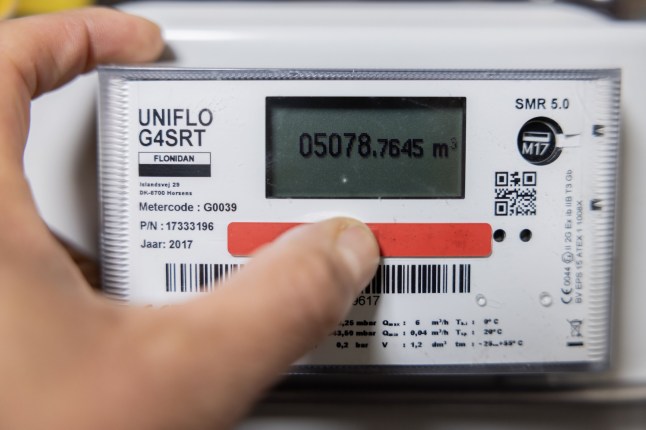
A default tariff puts you at the whim of fluctuations in the energy markets. You could see your bills drop, but equally they could soar.
If you want more stability, you could opt into a fixed-price deal that sets your tariff for a specific period of time. Often this is for a year.
Four million households have made this move since the last price cap was announced in November, according to Ofgem.
The largest move to fixed tariffs since the energy crisis, it brought total on fixed-price plans to 11million.
Is the government doing anything to help?
Energy Secretary Ed Miliband has announced new proposals that would mean nearly three million more families receive the £150 Warm Home Discount next winter.
Calling the latest rise in the cap ‘worrying news for families’, Miliband said the government is ‘determined to do everything we can to protect people from the grip of fossil fuel markets’.
He added: ‘Expanding the Warm Home Discount can help protect millions of families from rising energy bills, offering support to consumers across the country.
‘Alongside this, the way to deliver energy security and bring down bills for good is to deliver our mission to make Britain a clean energy superpower with homegrown clean power that we in Britain control.’
But the Conservative Acting Shadow Energy Secretary Andrew Bowie said the hike was a ‘betrayal to the families who Ed Miliband promised to save £300 on their bills’.
And Liberal Democrat leader Sir Ed Davey called for the increase to be scrapped for the pensioners who recently lost their Winter Fuel Payment.
Get in touch with our news team by emailing us at webnews@metro.co.uk.
For more stories like this, check our news page.
19 Feb, 2025 | Admin | No Comments
New Zealand tourism slogan slammed for sounding like ‘we’re in a clearance bin’


New Zealand’s latest tourism campaign has not achieved the effect it was hoping for.
Instead, the new tagline, ‘Everyone must go!’ has caused controversy, with many describing it as ‘tone-deaf’ at a time of record emigration and unemployment rates in New Zealand.
The marketing ploy launched last weekend on social media and radio and was designed to encourageAustralians – the country’s biggest tourism market – to visit.
But the advert, which cost $500,000 (£226,494), has drawn backlash. Critics, including Labour MP Cushla Tangaere-Manuel, have questioned the slogan’s quality and cost.
RNZ, New Zealand’s public media service, shared the campaign on their socials, reporting that residents have been mocking the slogan.
‘Everyone must go? They are going, leaving in droves because they have no work or prospects left here,’ one person commented, while another questioned: ‘How much for that branding?’

Others said they were embarrassed by the advert, while further commenters suggested it was ‘trying to fill the vacancies made by record Kiwis that left.’
Green Party tourism spokesperson Celia Wade-Brown told RNZ: ‘I think ‘Everyone Must Go’ might refer to the need for toilets in some of our high-tourist spots. I mean, the queues are ridiculous’
Cushla Tangaere-Manuel, Labour’s tourism spokesperson agreed that it ‘makes New Zealand sound like we’re in a clearance bin at a sale.’
Tangaere-Manuel referred to the ‘many cuts’ taking place across the country, and stated: ‘The irony of that messaging is, that’s how Aotearoa New Zealanders are feeling right now.’ Aotearoa is the Māori name for New Zealand.
However, government officials have been defending the advert.
In a news release, Tourism Minister Louise Upston said: ‘What this Tourism New Zealand campaign says to our Aussie mates is that we’re open for business, there are some great deals on, and we’d love to see you soon.’
Prime Minister Christopher Luxon said he ‘[knows] there’s lots of chat about whether everyone loves the slogan or not.’ But ‘the fact that we’re talking about it is a good thing.’
The campaign comes at a time of mounting job cuts, high cost of living, and mass relocation.
New Zealand’s economy has been struggling in recent years, falling into a technical recession in the third quarter of 2024.
HSBC described the country as ‘suffering the biggest hit in the world in 2024’ as interest rates and inflation strained the country’s economy.

Recent data released by Statistics New Zealand revealed that 127,800 people left the country in the 12 months through November. This was a 28% rise compared to last year.
These figures also mark the highest number of people leaving the Pacific nation in an annual period at any point in history.
Last year, over 3.3 million tourists visited New Zealand – a 12% increase from 2023. Out of these travellers, 1.2 million were from Australia.
In January, New Zealand announced they would relax visa rules to allow digital nomads to work remotely for a foreign employer, in the hope of boosting visitor spending.
